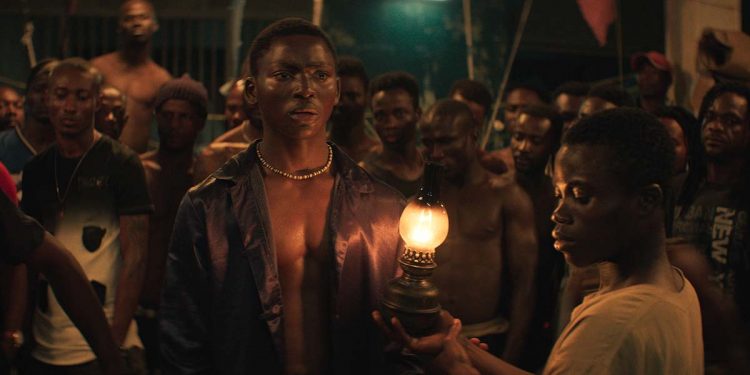In Philippe Lacôte’s moody “Night of the Kings,” telling stories becomes an act of survival. It’s a sharply incisive hook that sees the film presenting itself as a meta-textual examination on the implications of storytelling and myth in Côte d’Ivoire. The film opens with a young pickpocket on his way to MACA, a prison in Abidjan. As he rides on the back of a pick-up truck, guarded by a uniformed officer, the ominous barbed fences of the prison appear out of the shadows, like a world on to itself. And it is. At MACA, the officers are more custodians than anything, as the prison has its own hierarchy where the inmates have created their own mythologised customs.
At the top of the hierarchy is the imposing Blackbeard, a fearsome leader in many ways but for the fact that his breathing is dependent on an oxygen machine. It’s one of many complications to come. MACA’s rule-of-law demands that a king who can no longer lead must abdicate the throne by committing suicide. Blackbeard mulishly considers how to delay this fate. The arrival of the young pickpocket signals a potential reprieve. The newcomer arrives on the night of the red moon. Tradition dictates that the inmates stay up when the red moon is out, and a storyteller is chosen to weave a tale to hold their attention through the night. If he doesn’t, his fate is dubious. And so, the young pickpocket – renamed Roman by Blackbeard – must now struggle to weave a tale, for his own survival.

With this hook, “Night of the Kings” becomes a sharply self-aware story. Lacôte examines the reflexive nature of storytelling and the film calls attention to its own illusions throughout. The actual storytelling takes some time to begin, but even before that Lacôte is building the rules and aesthetics of this word in increasing complex ways. Samuel Teisseire’s production design distinguishes the different quarters of the jail as its own community with distinctive attention to detail as we move from Blackbeard’s kingly quarters to other places of more squalor. Any story depends on immersion in its world, and “Night of the Kings” is immediately extricating the limits and parameters of MACA.
As Blackbeard contemplates his abdication, two nascent factions are fighting for imminent power. Meanwhile, the jail’s resident crossdresser lends an air of melancholic sexuality to the jail’s own ambivalent gender politics. When Roman begins his tentative story, it is about Zama King – a notorious gang leader in Abidjan. But as Roman becomes aware of the stakes, the story begins to moprh into something else shifting from realistic tragedy to fantasy to action to thriller to pathos and on and on. His story is represented by brief scenes that realise his words in vivid fantasy sequences, but also accompanied by the inmates acting out his words in thrilling sequences where oral tradition meets choreography. As the story develops, Lacôte’s point becomes clearer. The specifics of the story are incidental. Like a typical fable, “Night of the Kings” is about the suggested and evoked rather than the explicated.
Canadian cinematographer Tobie Marier Robitaille develops Lacôte’s interest in the symbolic with his work here. “Night of the Kings” is one of the best-looking films of TIFF this year, not just on an aesthetic level of composing pretty shots but in the way that the film’s camera is consistently excavating its surroundings in thrilling and complex ways. The jail is photographed like a world on to its own, lit by lamps and flames and countered by shadows. Robitaille incisively establishes both the terrifying isolation of its surrounding as well as the almost mystical sense of distance that is projected. His work with light is central and it’s a key part of Lacôte’s work here which eschews tropes of jail narratives, presenting the community of these men with empathetic understanding and grace rather than the exploitive. This is a community of people with rules and customs that “Night of the King” observes with thoughtfulness.
Like many fables, “Night of the Kings” is more enticing when it is asking questions than when it deigns to provide answers. So, the film’s rushed conclusion feels inevitable in the places it goes but also somewhat beside the point of the narrative. But it is no cop-out to consider the film more of a mood piece than a traditional narrative. The ambivalent way the film treats the plot seems by design, rather than by lack of skill. So, here, this tale of a fateful night in a jailhouse is consistently evocative.
In a way, Lacôte’s own screenplay seems to be shrewdly pointing out the limits of stories. The specificity of the plots becomes peripheral to the ways they make us feel and react. In “Night of the Kings” storytelling is a reprieve, functional and necessary, from the reality at hand. It is less about the specificity of the story than it is about its existence. It’s an intriguing argument since Lacôte manages to achieve this almost Romantic-era aesthetic solidarity while excavating real social issues with sensitivity.
The images and sequences are less about the specifics of the story than about the moods and images they convey, and suggest. The storytelling that becomes central mimics this in deliberately ironic ways, so that by the end – it is as if Lacôte is trying to tell us that clarity and understanding is not a given. Instead, what this Night of Kings offers is a haunting recurring image of a moon fading that seems to say all that we need to know.





